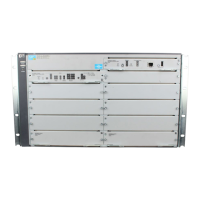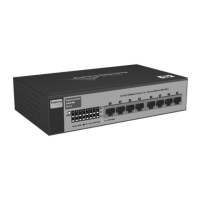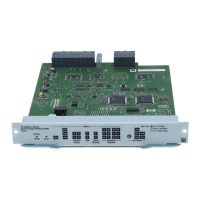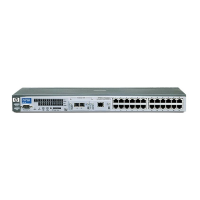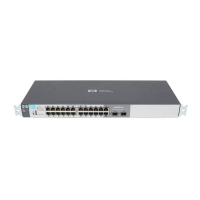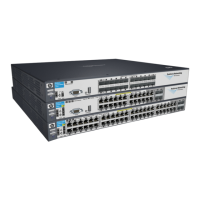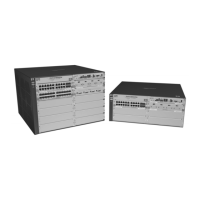HP ProCurve Switch 8212zl
3
• IEEE 802.3ad Link Aggregation Control Protocol (LACP) and
ProCurve trunking: support up to 60 trunks, each with up to 8
links (ports) per trunk; trunking across modules is supported
• Hot-swappable modules: interface, management, and fabric
modules as well as mini-GBIC optics and power supplies can be
removed, swapped, or added to the system without interrupting
ongoing switch operations
• Redundant, scalable power design: add/deploy redundant
power supplies to expand power capacity and provide redundancy
to ensure network productivity
• Redundant switch fabric: dual, performance load-sharing fabric
modules provide enhanced system availability and seamless
system resiliency
• Redundant switch management: dual management modules
provide active/standby operation to enhance system availability
• Redundant, hot-swappable cooling: redundant fan design and
hot-swappable fan tray ensure continuity of operation in case of a
single fan failure
• Passive system design: passive chassis backplane (no
traffic-forwarding active componentry) ensures system reliability
and reduces impact of component failure
Layer 2 switching
NEW IEEE 802.1ad Q-in-Q: increases the scalability of Ethernet
network by providing a hierarchical structure; connects multiple
LANs on high-speed campus or metro network
• ProCurve switch meshing: dynamically load-balances across
multiple active redundant links to increase available aggregate
bandwidth
• VLAN support and tagging: supports the IEEE 802.1Q
standard and 2,048 VLANs simultaneously
• IEEE 802.1v protocol VLANs: isolate select non-IPv4 protocols
automatically into their own VLANs
• GARP VLAN Registration Protocol: allows automatic learning
and dynamic assignment of VLANs
Layer 3 services
• UDP helper function: UDP broadcasts can be directed across
router interfaces to specific IP unicast or subnet broadcast
addresses and prevent server spoofing for UDP services such as
DHCP
• Loopback interface address: defines an address in RIP and
OSPF that can always be reachable, improving diagnostic
capability
Layer 3 routing
• Static IP routing: provides manually configured routing; includes
ECMP capability
• RIP: provides RIPv1 and RIPv2 routing
• OSPF: includes host-based ECMP to provide link
redundancy/scalable bandwidth and NSSA
Security
• Switch CPU protection: provides automatic protection against
malicious network traffic trying to shut down the switch
• Virus throttling: detects traffic patterns typical of WORM-type
viruses and either throttles or entirely prevents the ability of the
virus to spread across the routed VLANs or bridged interfaces,
without requiring external appliances
• ICMP throttling: defeats ICMP denial-of-service attacks by
enabling any switch port to automatically throttle ICMP traffic
• Multiple user authentication methods:
- IEEE 802.1X: industry-standard way of user authentication using
an IEEE 802.1X supplicant on the client in conjunction with a
RADIUS server
- Web-based authentication: authenticates from Web browser
for clients that do not support 802.1X supplicant; customized
remediation can be processed on an external Web server
- MAC-based authentication: client is authenticated with the
RADIUS server based on client's MAC address
• Authentication flexibility:
- Multiple IEEE 802.1X users per port: provides authentication of
multiple IEEE 802.1X users per port; prevents user "piggybacking"
on another user's IEEE 802.1X authentication
- Concurrent IEEE 802.1X, Web, and MAC authentication
schemes per port: switch port will accept up to 32 sessions of
IEEE 802.1X, Web, and MAC authentications
• Access control lists (ACLs): provide filtering based on the IP
field, source/destination IP address/subnet, and source/destination
TCP/UDP port number on a per-VLAN or per-port basis
• Identity-driven ACL: enables implementation of a highly
granular and flexible access security policy and VLAN assignment
specific to each authenticated network user
• DHCP protection: blocks DHCP packets from unauthorized
DHCP servers, preventing denial-of-service attacks
• STP BPDU port protection: blocks Bridge Protocol Data Units
(BPDUs) on ports that do not require BPDUs, preventing forged
BPDU attacks
• Dynamic IP lockdown: works with DHCP protection to block
traffic from unauthorized hosts, preventing IP source address
spoofing

